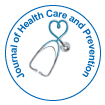Drivers and Impact of Emerging Infectious Diseases on Global Health
Received: 01-Mar-2025 / Manuscript No. jhcpn-25-163692 / Editor assigned: 03-Mar-2025 / PreQC No. jhcpn-25-163692(PQ) / Reviewed: 17-Mar-2025 / QC No. jhcpn-25-163692 / Revised: 21-Mar-2025 / Manuscript No. jhcpn-25-163692(R) / Published Date: 28-Mar-2025
Abstract
Emerging infections refer to diseases that have recently appeared in populations or those whose incidence and geographic spread are rapidly expanding. These infections pose significant risks to global health, often leading to economic instability and stressing public health systems. Key drivers of the emergence of infectious diseases include increased human mobility through globalization, climate change, rapid urbanization, antimicrobial resistance (AMR), and changes in agricultural practices. Globalization facilitates the swift spread of diseases across borders, while climate change alters the distribution of disease-carrying vectors such as mosquitoes. Urbanization and population growth increase human-wildlife interactions, promoting the emergence of zoonotic diseases that can cross species barriers, such as Ebola. The growing threat of antimicrobial resistance exacerbates the situation, with the overuse of antibiotics giving rise to resistant bacteria like MRSA and multi-drug-resistant tuberculosis (MDR-TB).
Introduction
Emerging infections are diseases that either have recently appeared in human populations or are showing a rapid increase in incidence or geographic spread. These infections may stem from newly identified pathogens or from existing microorganisms that have evolved to become more transmissible or resistant to existing treatments. The rise of emerging infections presents substantial threats to global health, economic stability, and public health infrastructure. Addressing these threats requires a coordinated, multidisciplinary approach to prevent outbreaks and mitigate their impacts. Factors contributing to the emergence of infectious diseases include globalization, which enables rapid cross-border transmission, and climate change, which impacts the distribution of disease vectors. The COVID-19 pandemic serves as a poignant example of how swiftly a new infection can spread and overwhelm global healthcare systems.
Methodology
Addressing emerging infections necessitates a comprehensive and interdisciplinary approach to monitor, prevent, and respond effectively to outbreaks. Several key methods are utilized in research and response strategies for emerging infectious diseases:
- Epidemiological surveillance: Surveillance is crucial for detecting and monitoring emerging infections. This involves systematically collecting, analyzing, and interpreting health data to identify trends and outbreaks. Surveillance can include sentinel sites, disease reporting systems, and real-time data platforms. Syndromic surveillance, tracking specific symptoms, provides early warning signs of emerging diseases. Advanced genomic surveillance, including sequencing technologies, tracks pathogen evolution and helps identify new strains.
- Mathematical modeling and predictive analysis: Mathematical models simulate the spread of diseases and predict future outbreaks. These models incorporate variables such as population density, mobility, and climate to understand transmission dynamics. Predictive models are useful for identifying hotspots and evaluating intervention strategies, such as vaccination and social distancing. Such models were essential in forecasting infection rates during the COVID-19 pandemic.
- Field investigations and ecological studies: Ecological studies help to understand the context in which emerging infections arise, particularly zoonotic diseases. Field investigations examine human-animal-environment interactions to pinpoint infection sources. These studies monitor wildlife populations, identify disease reservoirs, and assess environmental factors like deforestation and climate change that facilitate pathogen spillover, as seen with diseases like Ebola and Nipah virus [1-5].
- Laboratory research and pathogen characterization: Laboratory research focuses on isolating and understanding the biology of emerging pathogens. Techniques like PCR, next-generation sequencing, and serological assays help identify new viruses, bacteria, and fungi, as well as understand their genetic makeup. This research is also critical for developing diagnostics, vaccines, and therapeutics. The rapid development of COVID-19 vaccines, for instance, was made possible by studying the genetic structure of the SARS-CoV-2 virus.
- Public health interventions and risk communication: Effective interventions, such as vaccination campaigns, quarantine measures, and vector control, are based on research and surveillance data. Risk communication is essential for educating the public on prevention strategies, promoting vaccine acceptance, and combating misinformation. Clear communication fosters public trust and is vital for the success of containment efforts.
- One health approach: The One Health approach recognizes the interdependence of human, animal, and environmental health. Collaboration across sectors like veterinary medicine, public health, and agriculture is key to identifying and mitigating the risks posed by emerging infections. This approach allows for early prediction of zoonotic spillovers and the development of early intervention strategies [6-10].
Conclusion
Emerging infections pose a significant and persistent challenge to global health. Addressing these threats requires continued vigilance, innovation, and international collaboration. The experiences with COVID-19, Zika, and other emerging pathogens highlight the urgent need for resilient health systems capable of responding quickly to new threats. By investing in surveillance, research, and public health infrastructure, the global community can better prepare for future outbreaks and minimize the devastating effects of emerging infections. As pathogens evolve in response to factors like climate change, globalization, and antimicrobial resistance, the potential for new outbreaks remains high. The COVID-19 pandemic serves as a stark reminder of how rapidly a new pathogen can disrupt societies and healthcare systems worldwide.
Acknowledgment
None
Conflict of Interest
None
Citation: Sofoulaki SK (2025) Drivers and Impact of Emerging Infectious Diseaseson Global Health. J Health Care Prev, 8: 306.
Copyright: © 2025 Sofoulaki SK. This is an open-access article distributed underthe terms of the Creative Commons Attribution License, which permits unrestricteduse, distribution, and reproduction in any medium, provided the original author andsource are credited.
Select your language of interest to view the total content in your interested language
Share This Article
Recommended Journals
Open Access Journals
Article Usage
- Total views: 88
- [From(publication date): 0-0 - Sep 02, 2025]
- Breakdown by view type
- HTML page views: 63
- PDF downloads: 25
